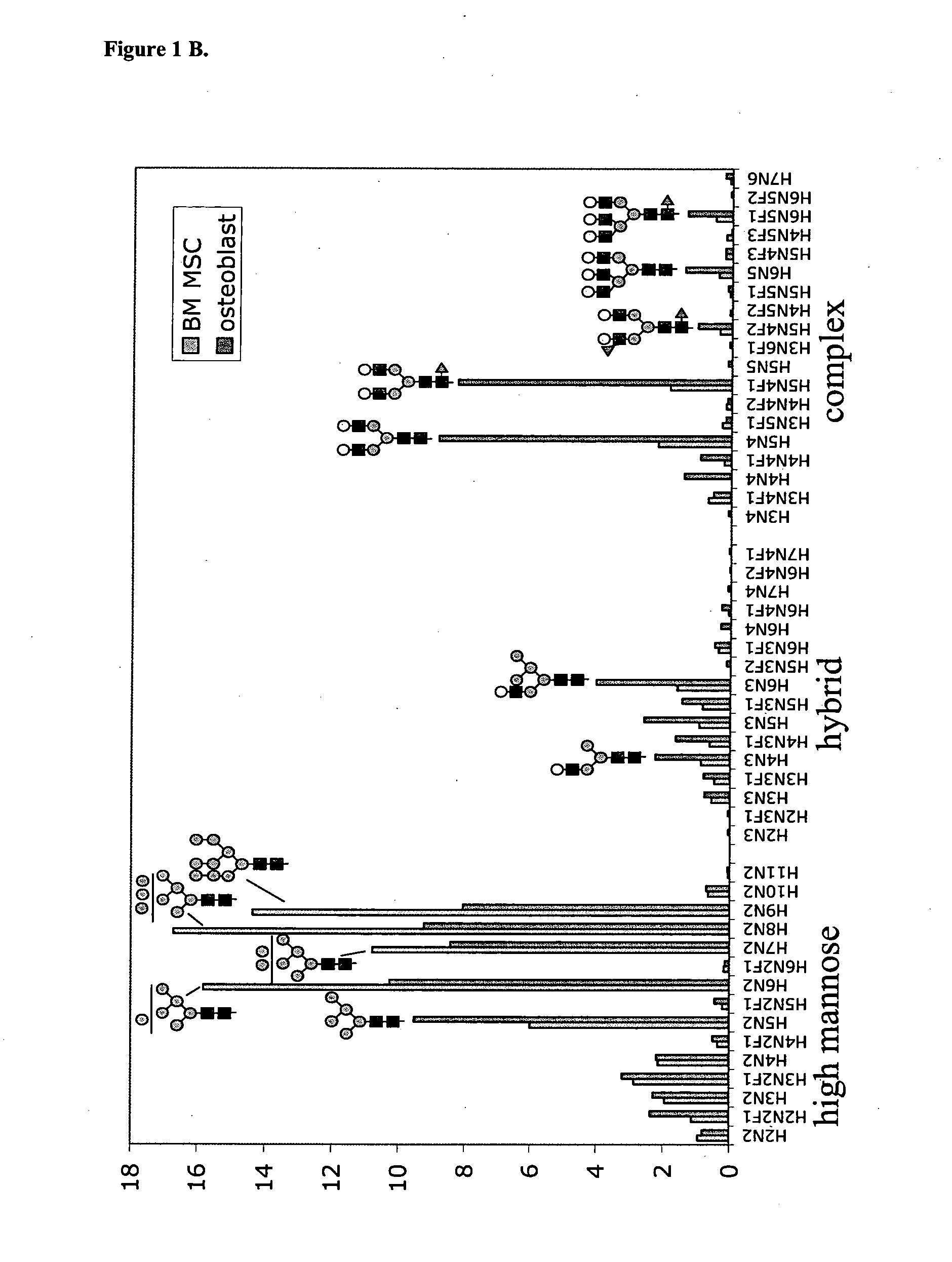Novel specific cell binders
a technology of specific cell binders and glycans, applied in the direction of animal cells, material testing goods, biochemistry apparatus and processes, etc., can solve the problems of inability to isolate stem cells from organs or peripheral blood, inability to identify and isolate multipotent “embryonic-like” stem cells using known markers, and inability to carry a considerable risk to the fetus
- Summary
- Abstract
- Description
- Claims
- Application Information
AI Technical Summary
Benefits of technology
Problems solved by technology
Method used
Image
Examples
example 1
MALDI-TOF Mass Spectrometric N-Glycan Profiling, Glycosidase and Lectin Profiling of Cord Blood Derived and Bone Marrow Derived Mesenchymal Stem Cell Lines
[1483]Examples of Stem Cell Sample Production
[1484]Cord Blood Derived Mesenchymal Stem Cell Lines
[1485]Collection of umbilical cord blood. Human term umbilical cord blood (UCB) units were collected after delivery with informed consent of the mothers and the UCB was processed within 24 hours of the collection. The mononuclear cells (MNCs) were isolated from each UCB unit diluting the UCB 1:1 with phosphate-buffered saline (PBS) followed by Ficoll-Paque Plus (Amersham Biosciences, Uppsala, Sweden) density gradient centrifugation (400 g / 40 min). The mononuclear cell fragment was collected from the gradient and washed twice with PBS.
[1486]Umbilical cord blood cell isolation and culture. CD45 / Glycophorin A (GlyA) negative cell selection was performed using immunolabeled magnetic beads (Miltenyi Biotec). MNCs were incubated simultaneous...
example 2
Lectin and Antibody Profiling of Human Mesenchymal Stem Cells
[1520]Experimental Procedures
[1521]Cell samples. Bone marrow derived human mesenchymal stem cell lines (MSC) were generated and cultured in proliferation medium as described above.
[1522]FITC-labeled lectins. Fluorescein isotiocyanate (FITC) labelled lectins were purchased from several manufacturers: FITC-GNA, -HHA, -MAA, -PWA, -STA and -LTA were from EY Laboratories (USA); FITC-PSA and -UEA were from Sigma (USA); and FITC-RCA, -PNA and -SNA were from Vector Laboratories (UK). Lectins were used in dilution of 5 pg / 105 cells in 1% human serum albumin (HSA; FRC Blood Service, Finland) in phosphate buffered saline (PBS).
[1523]Flow cytometry. Flow cytometric analysis of lectin binding was used to study the cell surface carbohydrate expression of MSC. 90% confluent MSC layers on passages 9-11 were washed with PBS and harvested into single cell suspensions by 0.25% trypsin −1 mM EDTA solution (Gibco). The trypsin treatment was ai...
example 3
Lectin and Antibody Profiling of Human Cord Blood Cell Populations
[1535]Results and Discussions
[1536]FIG. 1 shows the results of FACS analysis of FITC-labelled lectin binding to seven individual cord blood mononuclear cell (CB MNC ) as an example of mainly associated / control cells in context of CB MSC preparations (experiments performed as described above). Strong binding was observed in all samples by GNA, HHA, PSA, MAA, STA, and UEA FITC-labelled lectins, indicating the presence of their specific ligand structures on the CB MNC cell surfaces. Also mediocre binding (PWA), variable binding between CB samples (PNA), and low binding (LTA) was observed, indicating that the ligands for these lectins are either variable or more rare on the CB MNC cell surfaces as the lectins above.
PUM
| Property | Measurement | Unit |
|---|---|---|
| anomeric structure | aaaaa | aaaaa |
| end elongation | aaaaa | aaaaa |
| elongation | aaaaa | aaaaa |
Abstract
Description
Claims
Application Information
 Login to View More
Login to View More - R&D
- Intellectual Property
- Life Sciences
- Materials
- Tech Scout
- Unparalleled Data Quality
- Higher Quality Content
- 60% Fewer Hallucinations
Browse by: Latest US Patents, China's latest patents, Technical Efficacy Thesaurus, Application Domain, Technology Topic, Popular Technical Reports.
© 2025 PatSnap. All rights reserved.Legal|Privacy policy|Modern Slavery Act Transparency Statement|Sitemap|About US| Contact US: help@patsnap.com



